
Maharaja Vikramaditya Series : POST 1
MAHARAJA VIKRAMADITYA OF UJJAIN
Maharaja Vikramaditya is considered one of the greatest Indian kings to have ever ruled Bharat from his capital Ujjain. Over a period of time history made him a mythical figure, though he was actually part of Bharat’s history and even referred to in many literary works and Puranas. Why is it important to know more about Maharaja Vikramaditya now?
Why is it important to know more about Maharaja Vikramaditya now?
As per the divine revelation of Lord Muruga to Shri Rejith Kumar in 2021 Maharaja Vikramaditya is one of the great spiritual powers guiding the LMRK Mission in its duties in today’s world i.e. during the Muruga Yugam. It is significant to know that Special Prayers had been offered to Maharaja Vikramaditya and his courtiers the ‘Navaratnas’ before performing the third divine duty of the LMRK Mission – the ‘Skandha Bharatha Maha Yagam’ in Pazhani by Shri Rejith Kumar under the divine direction of Lord Muruga.
The purpose of this article is to briefly explore and bring out information about this great emperor who ruled his vast empire from Ujjain, India more than 2,000 years ago from various literary and archeological evidence.
“Purne thrimsachchate Varshe
Kalau prapte bhayamkare
Sakanamcha Vinasardham Arya
Dharma Vivruddhaye
Jatassivajnaya sopi Kailasat Guhyakalayat”
(Maha Bhavishya Purana, 3-1-7-14,15)
“Vikramaditya namanam pita Krutwa mumodaha
Sa balopi mahaprajanah pithru Mathru priyamkarah” “Pancha Varshe vayah prapte
Tapasordhe vanam gatah
Dwadasabdam prayathnena
Vikramena krutam tapah” “Paschadambavatim divyam Purim yatah sriyanvitah
Divyam simhasanam ramyam
Dwathrimsan murthi samyutam”
(Maha Bhavishya Purana, 3-1-7-16,17,18)
The Mahabhivshya Purana narrates that the great King was born after 3000 years of Kali yuga at the command of Lord Shiva from the world of Guhakyas (celestial world) to uplift dharma. (Kali Yuga exactly began in the year 3102 BC as per the Puranas so the year 102 BC is when this divinely blessed soul is said to have been born). He was born on earth to the great king Gandharvasena (of the Paramara dynasty). His father named him Vikramaditya and rejoiced greatly. As a boy, he was very wise and pleased his parents. When he was 5 years old, Vikrama went to the forest and did penance for 12 long years. Having enriched himself with wisdom, he approached the sacred city of Ambavati (Ujjain) and was anointed as a king on a golden throne with 32 golden figurines.
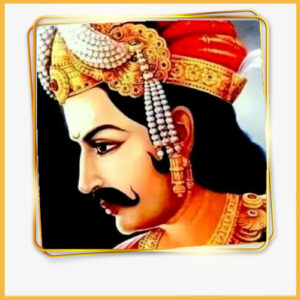
According to the Maha Bhavishya Purana, the legendary King Vikramaditya was given a transcendental throne by Lord Shiva Himself. He was sent a ‘Vetala’ (King of Ghosts) by Goddess Parvathi to the palace for his protection. He was known for his generosity, courage, and patronage of scholars. (His connection with the ‘Vetala’ (Ghost or ‘Vethalam’) which asked him 25 questions is mentioned in ‘‘Baital Pachisi’ and his transcendental throne with 32 figurine dolls which later spoke about his greatness to one of his descendants Maharaja Bhoja is mentioned in the books ‘Singhasan Battisi’ many centuries later and remembered till today).
Maha Bhavishya Purana also reveals that the powerful king Maharaja Vikramaditya used to visit the temple of Shiva named as ‘Mahakaleshwara’, the chief of the Devas and who has a bow named ‘Pinaka’. He worshipped Lord Shiva there. He also built a religious council hall there with pillars made of various metals and decorated with many kinds of jewels. It was further beautified by the presence of many plants, creepers, and flowers. He had placed his celestial throne in that hall. He invited the foremost Brahmanas who were well versed with Vedic knowledge and paid due respect to them with proper hospitality and enriched himself with knowledge by hearing many religious stories from them.
On the eve of his ascending the throne adorned with thirty-two golden statues, came a demigod named ‘Vitala’ in the form of a learned Brahmin. Glorifying and blessing the king, he sat down on his seat and said:” O Master of this earthly planet, king Vikramaditya, if you are very eager to hear then, I will narrate the stories and histories to you.” He delayed the coronation ceremony with a purpose to teach the king a history consisting of several episodes, wherein the rights and duties of a monarch were enumerated. Then he taught Vikramaditya all the rights and responsibilities he owed to himself and his subjects and gave him a befitting and efficient training worthy of an illustrious Sovereign. Later, in the year Kali 3020 or 82 BC Vikramaditya was crowned King. Then he expelled the Sakas and drove them as far as Bactria, conquered the whole of Bharat from the Himalayas to Sethu, and received tribute from the feudatory kings.
(Maharaja Vikramaditya was an Agni Vamsi and the 8th descendant of the Paramara or Panwardynasty. He was the second son of King Gandharvasena and was crowned as the King in 82 BC after his brother Bharathari abdicated his throne for pursuing spirituality).
“The boundaries of Maharaja Vikramaditya’s empire in Bharat extended from the Indus River in the west, Badaristhana (Badrinath) in the north, Kapila (Kapilavastu) in the east and Sethubandha (Rameshwaram) in the south”.(Maha Bhavishya Purana).
Another Shloka of the Maha Bhavishya Purana (3-4-1:2) states “By the grace and command of Siva, Gandharvasena’s son, Vikramaditya reigned as Emperor, for hundred years. His son Maharaja Vikramaditya “Devabhakta” after ruling for ten years, was killed in a battle by the cruel Sakas.”(Kali 3130 or 29 A.D.).
King Vikramaditya performed an Ashvamedha Yagna to establish his supremacy as an emperor. The sacrificial horse was sent to the lands of other kingdoms. Those who accepted him as the emperor allowed the horse to pass without a fight, otherwise, a battle would be fought and the boundary defined. Having consolidated his empire, Maharaja Vikramaditya went to Nepal.
According to the Nepala Raja Vamsavali, Maharaja Vikramaditya the Indian emperor is said to have visited Nepal in 57 BC where King Amsuvarman of the Thakuri dynasty accepted the status of ‘Samantha’, within his empire and as a symbol of his over-lordship had inaugurated his era in Nepal in 57 BC. This is published in the Indian Antiquary Vol.XIII p.411. (Ref: P.16 of in Chronology of Nepal Reconstructed by Kota Venkatachalam Rao). King Amsuvarman is said to have reigned from (101 BC to 33 BC) while Vikramaditya is said to have ruled for 100 years from (82 BC to 19 AD).
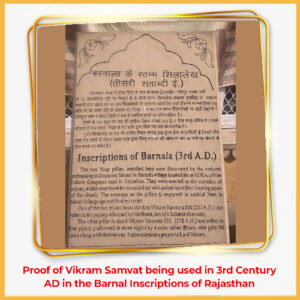
Vikram Samvat the calendar was named after King Vikramaditya in 57 BC to mark his victory over the Sakas who invaded Ujjain. This can be verified by the usage of the almanac in the northern, western and central states of India as well as in Nepal. For example – the pillars of Barnal in Rajasthan installed in 227 AD and 278 AD give sufficient proof that the Vikram Samvat (Era) was recognised as starting from 57BC. In Nepal, the Vikram Samvat is referred to as ‘Bikram Sambat’ and used as their official almanac (Panchang).
He went on to conquer Babylon, Persia, Turkistan, Arabia, and other Western Asia countries. He showed utmost forbearance towards them and called himself the ‘King of Aryavrata and Liberator of the Arabs, Turks, and the Jews”. Vikramaditya had the wisdom of leaving the institution of the kingdoms he attached to his empire unchanged and this earned him the respect and adoration of all those he conquered.
Maharaja Vikramaditya was considered a great and wise ruler by all those he ruled. He was known across his vast empire for his generosity and benevolence. For the first time, they got a King who cared for the subjects of his Empire. The Arabs, Kurds, and Persians saw him as the Lord’s Chosen One’. The respect and adoration they had for this Indian emperor can be found recorded in a volume called ‘Sayar-ul-Okul’ (meaning memorable worlds) and can be found in the Makhtab-e-sultania library in Istanbul, TurkJey. The translation of the inscription in free English reads as follows:
“…Fortunate are those who were born (and lived) during King Vikramaditya’s reign. He was a noble, generous, dutiful ruler, devoted to the welfare of his subjects. But at that time we Arabs, oblivious of God, were lost in sensual pleasures. Plotting and torture were rampant. The darkness of ignorance had enveloped our country. Like the lamb struggling for her life in the cruel paws of a wolf, we Arabs were caught up in ignorance. The entire country was enveloped in a darkness so intense as on a new moon night. But the present dawn and pleasant sunshine of education is the result of the favour of the noble King Vikramaditya Proof of Vikram Samvat being used in 3rd Century AD in the Barnal Inscriptions of Rajasthan whose benevolent supervision did not lose sight of us – foreigners as we were. He spread his sacred religion amongst us and sent scholars whose brilliance shone like that of the sun from his country to ours. These scholars and preceptors through whose benevolence we were once again made cognisant of the presence of God, introduced to His sacred existence, and put on the road of Truth, had come to our country to preach their religion and impart education at King Vikramaditya’s behest…” (Page 315 – Sayar-ul-Okul).
The text of this inscription was found inscribed on a gold dish hung inside the Kaaba shrine in Mecca. It was written by the Arabian poet Jarrham Bintoi who lived more than 165 years before Prophet Mohammed’s time. It was a tribute to Maharaja Vikramaditya who lived 500 years before Jarrham Bintoi. The annual fair known as ‘OKAJ’ used to be held every year around the Kaaba temple in Mecca where many scholars and poets was honoured for their literary work and the best were engraved on a gold plate and hung inside the Kaaba temple. Arabian Poet Jarrham Bintoi’s tribute to Vikramaditya was thus honoured this way on the sacred walls of the Kaaba.
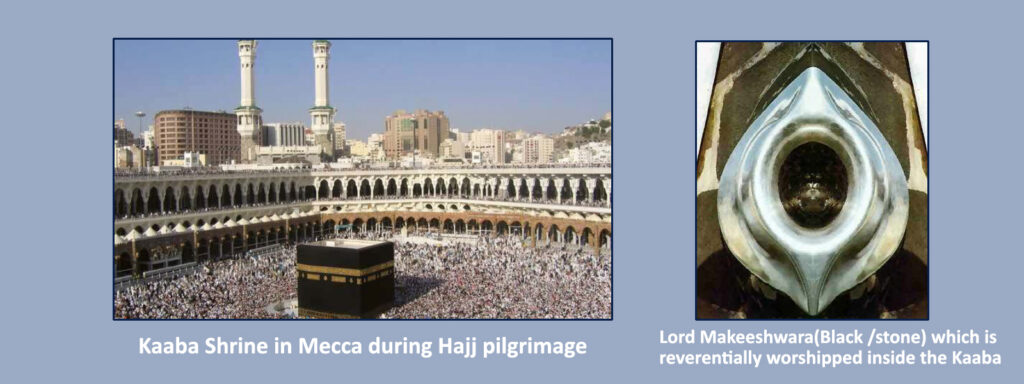
From this, we can summarise that Maharaja Vikramaditya not only was the first to annex Arabia to the Indian empire but he also cared for his subjects by spreading spiritual awareness and establishing places of worship. He sent scholars and preceptors who succeeded in fostering a dharmic way of life amongst the Arabs by instilling Vedic faith in them and had also broadened their minds through education.
During most of the year, the Kaaba is covered with an enormous cloth of black brocade, the ‘kiswah’. Located in the south-eastern corner of the Kaaba is the Black Stone of Mecca supported by a silver covering. It is believed by some historians that this ‘Black Stone’ (AlHajar-al-Aswad) is actually the Makkeshwara Shivalingam which existed from Pre-Islamic times. Vikramaditya was said to have stayed for a year in Arabia till the Mahadev temple was reconstructed. It is significant to know that ‘Makkeshwara’ in the Tamil Language is one of Lord Makkeshwara (Black Stone) which is reverentially worshipped inside the Kaba Kaaba Shrine in Mecca during Hajj pilgrimage the 1008 names for Lord Shiva. Mecca was called ‘Makkah’ in the olden days (Ref: Holy Quran).
Maharaja Vikramaditya restored Sanathana dharma and ensured that the Arabs followed a dharmic way of life by following the sacred Vedic scriptures. He was said to have built Vedic temples not only in the Middle East but also in Babylon, Persia, and Turkistan. Arabia was thus the center of Vedic civilisation in the Pre-Islamic era, i.e. during the time of Maharaja Vikramaditya. The Sanskrit word ’Arav’ means horses, and ’sthan’ means ‘land’. ‘Aravasthan’ or the ‘land of horses’ came to be known as ‘Arabsthan’ and then later as ‘Arabia’. Historian P.N.Oak states that this may explain why some west Asian countries all had or still have Sanskrit names like Afghanisthan (now Afghanistan), Baluchisthan, Kurdisthan, Tajikisthan, Uzbekisthan, Iran, Sivisthan, Iraq, Arvasthan, Turkesthan (Turkmenisthan) etc. Maharaja Vikramaditya accepted Persians as Aryans and called them long-lost cousins. During Maharaja Vikramaditya’s reign, Persians felt like they had felt under the golden reign of the famous Persian emperor Cyrus. He also built several monuments in the respect of Chandargupta Maurya and Cyrus.
He is credited with building the world’s longest road extending up to 1700 miles and starting an excellent postal system connecting his vast provinces. Due to the extensive and excellent network of relays, the postmen would travel the road in 6 to 9 days which would have otherwise taken them 3 months. This helped him to efficiently administer his vast empire. The motto of the Vedic postal service became memorable: stopped by neither snow, rain, heat, or gloom of night. His empire is said to have extended to many parts of modern-day China, the entire Middle East, and many parts of South East Asia.
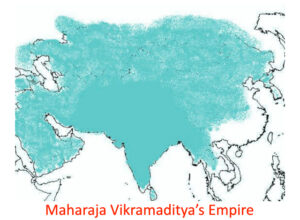
Vikramaditya’s Court mentioned in Ancient Vedic Astrology Books
He was an ideal ruler who always ensured that everyone benefitted from his decisions. He was a generous ruler who always thought of the welfare of his people and ruled accordingly. Even though he was a follower of Shaivism, he always treated all religions with equal respect. His court was filled with learned men and nine especially were known for their scholastic prowess in various fields. Maharaja Vikramaditya called them his nine gems. Kalidasa one of the Navaratna’s mentions their names in his astrological work Jyotirvidabharna written in between the months Vaisakha and Karthika (May-November) of 3068 Kali Era or (33 BC). They were:
- Dhanvantri
- Kshapanaka
- Amarasimha
- Sanku
- Vetalabhatta
- Ghatakarpara
- Kalidasa
- Varaha Mihira
- Vararuchi
Kalidasa details that the purpose of writing Jyotirvidabharna was to bring out the fame of Maharaja Vikramaditya. The 7th sloka in the 22nd chapter describes that i) Maharaja Vikramaditya’s empire was over the whole of Bharat-Varsha 180 big Jyotisha Yojana (approx. 1800 miles in length and breadth), ii) Bharat-Varsha shines forth with the culture of Veda and Dharma Sastras.
Kalidasa gives the list of poets and pundits in the court of Maharaja Vikramaditya
1. Sanku, 2. Vararuchi, 3. Mani, 4. Angudatta, 5. Jishnu, 6. Trilochana, 7. Hari (Hariswamy, the commentator of Sukla Yajurveda and the head of the departments of Dana and Dharma (Daanaadhyakshaa and Dharmaadhyakshaa), 8. Ghatakarpara, 9. Amarasimha, 10. Satyacharya, 11. Varahamihira, 12. Srutasena, 13. Badarayana, 14. Manittha, 15. Kumara Simha and astrologers, 16. Myself (Kalidasa), and others. (Slokas 22-8,9)
In (22-11) Kalidasa states that there were 800 Vassal Kings, 1 Crore good Soldiers, 16 great scholars, 16 efficient doctors, 16 bhattas, and 16 scholars of Vedic lore. In (22-12) His army continuously spread over 18 small Jyotish yojanas (each approximately 5 miles) and consisted of the following:
i) 3 Crore Soldiers, ii) 10 Crore Vehicles, iii) 24,300 elephants and iv) 400,000 Ships.
Kalidasa reiterates that in this respect no other emperor could be compared to Maharaja Vikramaditya.
In (22-13) – states that Vikrama annihilated innumerable Sakas and established the Era (Vikram Samvat). Every day he made gifts of pearls, gold, gems, cows, elephants, and horses to all the 4 castes and hence was called ‘Suvarnaanana”.
In (22-16) – says Ujjaiyini, the capital of Vikramaditya gives salvation to the inhabitants because of the presence of Lord Mahakaleshwar.
Sri Krishna Misra in his book Jyotishaphala-Ratnamala, a book on astrology dated (14 AD) gives a tribute to his king thus – “Let that Vikramarka, the Emperor, famous like the Manus, who protected me and my relations for seventy years, having endowed upon me one crore of gold coins flourish forever with success and prosperity”. (Sloka 10 of Jyotishaphala Ratnamala)
History of Kashmir – When the 82nd king in the list of the Kashmir monarchs, Hiranya died without leaving any heir to the throne, the cabinet of the ministers, in Kashmir sent a message to their over-lord Maharaja Vikramaditya, and requested him to depute a ruler. Then, out of his favour towards Matrigupta, a Scholar-poet of the court, Maharaja Vikramaditya installed MatriGupta with the sovereignty of his vassal state, Kashmir in 14 CE. [Rajatarangini 3rd Taranga written by Kalhana] (In 19CE Matrigupta abdicated his throne on hearing about the death of his beloved King Vikramaditya and later had become a spiritual recluse in Benares.)
(Reference: List of Taranga Kings in Chronology of Kashmir Reconstructed by Sri Kota Venkatachalam Rao)
Major General Sir Alexander Cunningham KCIE CSI was a British Army engineer with the Bengal Engineer Group who later took an interest in the history and archaeology of India and became a renowned Indologist. In his “Book on Indian Eras” on page 52, quoting Abu-Rihan Alberuni), as, “Saka was the name of the King who reigned over the country situated between the Indus and the sea; Vikramaditya marched against him and killed him in a battle fought near Korur, between Multan and the fort of Luni.” Further, Cunningham wrote in the 49th page of this book, “The era of Vikrama also said to have been established by Vikramarka Raja 470 years after Mahavira or in 527 -470 =57 B.C.”
John W. Mc Crindle, the western scholar, who authored many books and translations of Greek classical Literature, especially on Alexander, mentioned in “Ancient India as described by Ptolemy (100 AD- 170 AD)” edited in 1885 at Edinburgh (Munsiram Manoharlal) on pages 154 and 155 as, “Ozene – This is the translation of Ujjayani, the Sanskrit name of the old and famous city Avanti, still called Ujjain. It was the capital of celebrated Vikramaditya, who having expelled the Skythians and thereafter established his power over the greater part of India, restored the Hindu monarchy to its ancient splendour. The date of the expulsion of Skythians by Vikramaditya which forms the era in Indian Chronology called Samvat (57 B.C.) about a century and a half after the Vikramaditya era, Ujjain was still a flourishing city.”
A.P. Sinnett, the western scholar who was also President, the Simla Electric Theosophical Society wrote in his book, “Esoteric Buddhism” (Indological Book House, Varanasi) on page 151 as, “The party of primitive Buddhism was entirely worsted, and the Brahman ascendancy completely re-established in the time of Vikramaditya about 80 B.C.” (A.P. Sinnett is referring to the reestablishment of Sanathana Dharma during Maharaja Vikramaditya’s period).
Legend about Ayodhya being Rediscovered by Maharaja Vikramaditya – A local legend in Ayodhya states that the city was re-discovered by Maharaja Vikramaditya, after having been lost for centuries. Maharaja Vikramaditya started searching for Ayodhya and met Prayaga, the King of Tirthas (Prayaga personified as the King of Holy Rivers). Guided by Prayaga, Maharaja Vikramaditya marked the place, but subsequently forgot its location. A yogi told him that he should let loose a cow and a calf and that Ayodhya would be found at the place where milk starts flowing from the cow’s udders. Using this advice, Maharaja Vikramaditya managed to re-identify the site of ancient Ayodhya.
Archeological Evidence
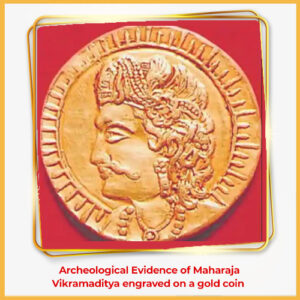
First Century BC Coin – As per the article published in Hindustan Times (Apr 12, 2013, 03:01 AM IST) Vikramaditya is no longer a legendary character but a historical one as per the researchers of Maharaja Vikramaditya Shodhpeeth in Ujjain. The small gold coin with the Maharaja Vikramaditya’s face engraved on it is the first definitive archeological evidence of the great monarch. A private collector had found this coin on the banks of river Shipra and had brought it to Shodhpeeth for authentication. Shodhpeeth researchers shared that though references have been earlier found relating to Maharaja Vikramaditya on terracotta and other copper seals and coins, this coin with the Maharaja Vikramaditya’s face on one side and the typical 1st century BC symbolisms on the other side was considered by them as the nailing evidence.
(Reference – 6). It is significant to know that the Vikramaditya Memorial statue located in Vikramaditya Mandir was modelled based on this engraving. (Reference – 7).
- 2100-year-old Trishul Sign Wall -found in the Mahakaleshwar temple (June 4TH 2021) – As reported in newsncr.com during the recent ongoing excavation around the Mahakaleshwar temple, engineers found a wall in the southern direction of the temple which was built during the reign of Maharaja Vikramaditya. It is significant to know Maharaja Vikramaditya was greatly devoted to Lord Mahakaleshwar of Ujjain. The symbol of Lord Shiva dating back to 2100 years (1st Century BC) was found on the wall. (Reference – 8).
Maharaja Vikramaditya liberated his subjects from ignorance and darkness and made the truth of Sanathana Dharma shine among his subjects. He believed in equality for all and won the hearts of all those whom he ruled. The various literary and archeological findings prove his existence in Indian history and his extensive contribution in fostering Sanathana Dharma.
References:
1) https://www.booksfact.com/history/emperor-vikramaditya-ujjain-actual-dates.html
2) https://kreately.in/inscription-of-hindu-king-vikramaditya-in-kaba/
3) King Vikramaditya of the Paramara Dynasty is a historical person of First Century B.C.E
– Dr.L.M.Raja,M.B, M.B, B.S, D.O.
4) Chronology of Kashmir Reconstructed by Sri Kota Venkatachalam Rao.
5) Chronology of Nepal Reconstructed by Sri Kota Venkatachalam Rao.
6) Archeological Evidence 1- https://www.hindustantimes.com/bhopal/vikramadityasteps-out-of-fables-into-history/story-myf7AvIkAVrySbYfSVuV2I.html
Archeological Evidence of Maharaja
Vikramaditya engraved on a gold coin
7) https://timesofindia.indiatimes.com/city/indore/after-centuries-ujjain-set-to-getvikramadityas-courtroom-again/articleshow/50877627.cms
8) Archeological Evidence 2- https://www.newsncr.com/national/2100-year-old-shivatrishul-sign-wall-found-in-mahakaleshwar-temple-was-built-under-the-rule-of-kingvikramaditya/ (June 4th , 2021)
9) https://freepresskashmir.news/2018/03/19/hindu-mahasabha-calendar-showskaaba-in-makkah-as-makeshwar-hindu-temple/
10) Navaratnas -https://www.hindujagruti.org/articles/2.html
11) https://www.britannica.com/topic/Kaaba-shrine-Mecca-Saudi-Arabia
12) Vedic roots in Pre Islamic Arabia and the Kaaba by P.N.Oak
13) http://trueindianhistory-kvchelam.blogspot.in/2010/01/date-of-emperorvikramaditya.html
14) https://en.wikipedia.org/wiki/Vikram_Samvat.
Research by: Mrs. Sowmya Nikhil


